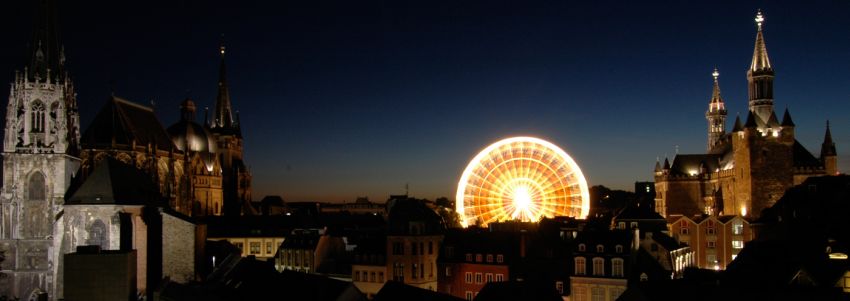Aachen - The Way It Was, The Way It Is
folklore, legend, fiction and the facts
Many old towns and cities in Europe love to enrich their early history by bringing in supernatural beings that range from gods to devils. Wherever these aliens are reported to have taken a hand in local events, the resulting mix-up of folklore, fiction and fact tends to create entertaining scenarios.
Aachen is one such old place. Its very name is a combination of fact and fiction: It is a fact the place boasts a special kind of water pouring out of hot springs, some of which are hot to well above 70 degrees Celsius. This water may smell like rotten eggs but it can be marvellous for the health. The Romans some two thousand years ago came to appreciate these hot springs and they named the place for its water, "aquae". A thousand years later, medieval clerics thought fit to add to this the name of an ancient god, Granus. This produced the double-barrelled place-name of "Aquisgranum".
At a later point in history, the Christian church took over and went for a name in French which is still being used today, "Aix-la-Chapelle".
This chapel, who built it ?
It is pure fiction but nice invention what people tell you about who financed the building of that chapel. Lack of funds, legend has it, drove the people of Aachen to enter into a pact with the Devil. For his contribution, the Devil demanded the soul of the first living being that was to enter the church after its completion. He was of course looking forward to snapping up a human soul. But he was tricked out of this most unholy scheme and what he eventually got was a wolf that the Aachen people had sent in first. Poor devil, he was so furious he slammed the church door closed, and lost his thumb in the process. Aacheners like to dish up this story, and they have a bit of the Devil‘s thumb in the one of the lion-faced church doors to show for it. Tourists like it.
Whether the known history of Aachen improves in terms of historical credibility is open to discussion. People have always had an urge ever so slightly to rewrite the historical truth. Be that as it may, what with emperors, aristocrats, merchants, clerics and also fortune-seekers like Casanova making an appearance in Aachen, a lot continued to happen in and around the ever-growing city of Aachen. Some people came who were seen as welcome guests But then there were also others, soldiers and conquerors, who Aachen was glad to see the backs of.
Down through the ages, most well-meaning visitors to Aachen have been entertained as friends and made very welcome.
And such visitors have been coming, to do the sights and enjoy the place or take the hot waters. Most of them were simple tourists, others high-ranking dignitaries, whose noble names are recorded for posterity on plaques put up in the town centre, in the rotunda of Elisenbrunnen where you can smell, and drink if you find the courage, the good water.
The Celtic god, the Devil, also the clever old woman who fooled the Devil, him again, so he dropped in anger the sack of sand he had brought to crush the church under, thus creating the now pleasant hill of Lousberg - the legends featuring these folkloric elements live on in fond memory.
Everywhere you look in Aachen the hard facts of its history are kept alive in its ancient civic and religious architecture, its medieval walols and gateways, its monuments and its, more recent, fine fountains.
To close the chapter on folklore, a legend of much less historical importance, mixing humour and domestic morals, will have to told; Aachen is home to the Bahkauv, a huge heavy beast that has been variously described. What is generall believed is it used to jump on men’s backs when they were trying to find their way home after an honest night of heavy drinking. Legend has it that in the bad old days there was great demand for the Bahkauv to be called in... In our days, the Bahkauv has the honour of its own monument in the area where some of those fine drinking places still flourish.
Aacheners of course will bring in the local hero, who is both a historical as well as historic figure. We are talking about Carolus Magnus as he would be called in Latin, or Charlemagne in French and English, that is Charles the Great, and Karl der Große in German. He enjoyed Aachen's hot health-giving springs a long time after the Devil and the Romans, a mere 1,200 years ago. Charlemagne had himself crowned Holy Roman Emperor by the Pope in Rome in 800 AD. It was around that time too that the construction of the church was began and completed that later on was to develop into Aachen Cathedral. This church started out as an eight-cornered chapel, the Octagon, definitely the gem of the whole structure as it developed later.
Another historical fact also bound up with Charlemagne is what by many is regarded as a very historic first. His empire after some vigorous military expansion spanned large areas of what is now the European Union, so Charlemagne has come to be credited with being the first ruler to have achieved a kind of European integration. Well, yes.
Charlemagne besides being a great warrior and ruler was also a gifted administrator. He had his palace, political headquarters built next to his church, though higher up on a hill. On the foundations of Charlemagne's palace later on today’s historic townhall was built and rebuilt, with parts being added on or refined over the centuries.
During the late Middle Ages, the Aachen townhall saw some 30 German kings crowned in its Great Hall. And, drawing on the idea of Charlemagne's first, though patchy and short-lived, go at European integration as well as all those festive coronations, over the last fifty years on May Day, it is in this townhall that the important Charlemagne Prize for contributions to European peace and unification has been given to international politicians and scholars, many of them being very deserving laureates. You will admit, in Aachen, there is no getting away from Charlemagne.
Thus, in 2003, what with our attempts at intercultural and inter-faiths understanding, we can witness a great international exhibition and conference arranged around Charlemagne.
It is a kind of historical evocation of the attempt made by the one great ruler, Charlemagne, to establish peaceful contact with his counterpart in Baghdad, the equally great ruler, Haroun al-Rashid. From one of the most important places in Christendom, Aachen, an ambassador, who was a Jewish merchant, was sent to Baghdad, to the then centre of Islam. The ambassador and the presents he brought were well received in Baghdad, and Haroun al-Rashid reciprocated by sending a white elephant back to Aachen, which duly arrived and was much lamented at its death.
So you see, Aachen has been making good use of its old history and stories. It has preserved its legacy and tradition carefully and, where desirable, constantly reshaped it and brought it up to date.
Today Aachen is a thriving city of some 250.000 inhabitants, its population in many ways being quite multicultural and multiracial. Its Technical University is internationally recognised.
It produces sweet gingerbread called "Printen" that is exported to almost any part in the world. It still is a spa whose thermal waters attracts many people seeking relief from rheumatism, arthritis and related problems.The annual International Aachen Horseshow combining show jumping, dressage and coach-driving events features the finest horses in the world.
Aachen is twinned with several sister cities in the USA, Great Britain, France and China. The most recent and probably the most exciting and people-orientated of these endeavours to many is the Capetown - Aachen Partnership.
To some, possibly the event that combines most of the features of Aachen as it was and as it is, the event that draws most spectacularly on local elements both religious and profane, the event that lives by the folklore and the fun life that are part of Aachen's tradition, the event that opens a window on Aachen humour and wit, that event would seem to be the Aachen carnival celebrated in the early year every year. In street parades and masked balls, in criticising, parodying and making fun of the great and the beautiful of the day, there is rough horseplay and good clean fun to be had for all those interested in this kind of thing.
The world is full of problems, and Aachen has its own share of them. They don't easily go away, and people are aware of that. But Aacheners have gone through times hard as well as good, they have shown they can deal with a lot.
Aachen has stayed afloat above the waves stirred up by fact or fiction, and its people will go on fighting to keep it that way, using what good fact and entertaining fiction they can find. They did it in the past, they will go on doing it.
Dr. Jürgen Jansen, Aachen




